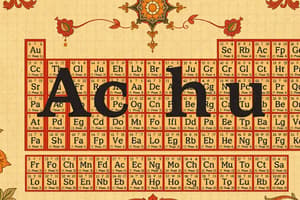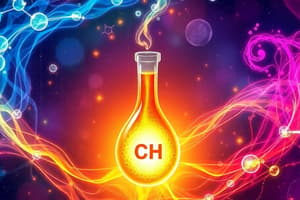Podcast
Questions and Answers
What type of hydrocarbon contains only single bonds between carbon atoms?
What type of hydrocarbon contains only single bonds between carbon atoms?
- Alkenes
- Alkynes
- Arene
- Alkane (correct)
Which functional group is represented by -OH?
Which functional group is represented by -OH?
- Carboxyl
- Amino
- Carbonyl
- Hydroxyl (correct)
What can be formed from the neutralization reaction between an acid and a base?
What can be formed from the neutralization reaction between an acid and a base?
- Hydrocarbons
- Metals
- Alkynes
- Salts (correct)
Which type of compound is formed by the complex association of metal ions with ligands?
Which type of compound is formed by the complex association of metal ions with ligands?
What equipment is essential for laboratory safety to protect your eyes from chemical splashes?
What equipment is essential for laboratory safety to protect your eyes from chemical splashes?
Which of the following describes a covalent bond?
Which of the following describes a covalent bond?
What is the primary characteristic of solid matter?
What is the primary characteristic of solid matter?
Which of the following is a type of reaction that involves the formation of a new compound from two or more reactants?
Which of the following is a type of reaction that involves the formation of a new compound from two or more reactants?
What defines an acid according to its behavior in a solution?
What defines an acid according to its behavior in a solution?
Which option correctly identifies characteristics of metals in the periodic table?
Which option correctly identifies characteristics of metals in the periodic table?
What is meant by activation energy in a chemical reaction?
What is meant by activation energy in a chemical reaction?
Which of the following statements is true regarding the periodic table?
Which of the following statements is true regarding the periodic table?
Which of the following defines a mole in chemistry?
Which of the following defines a mole in chemistry?
Flashcards are hidden until you start studying
Study Notes
Basic Concepts in Chemistry
- Matter: Anything that has mass and occupies space; exists in three states: solid, liquid, gas.
- Atoms: Basic units of matter; consist of protons, neutrons, and electrons.
- Protons: Positively charged particles found in the nucleus.
- Neutrons: Neutral particles also in the nucleus.
- Electrons: Negatively charged particles orbiting the nucleus.
Periodic Table
- Elements: Pure substances made of only one type of atom.
- Groups/Families: Vertical columns; elements share similar properties.
- Periods: Horizontal rows; show trends in properties.
- Metals, Nonmetals, Metalloids: Classification based on physical and chemical properties.
Chemical Bonds
- Ionic Bonds: Formed when electrons are transferred from one atom to another, creating ions.
- Covalent Bonds: Formed when atoms share electrons.
- Metallic Bonds: Formed by the attraction between metal ions and delocalized electrons.
Chemical Reactions
- Reactants: Substances that undergo change.
- Products: Substances formed as a result of the reaction.
- Types of Reactions:
- Synthesis: A + B → AB
- Decomposition: AB → A + B
- Single Replacement: A + BC → AC + B
- Double Replacement: AB + CD → AD + CB
- Combustion: Hydrocarbon + O2 → CO2 + H2O
States of Matter
- Solid: Definite shape and volume; particles tightly packed.
- Liquid: Definite volume but takes the shape of its container; particles are close but mobile.
- Gas: Indefinite shape and volume; particles are far apart and move freely.
Acids and Bases
- Acids: Substances that donate protons (H+) in a solution; taste sour.
- Bases: Substances that accept protons; taste bitter and feel slippery.
- pH Scale: Measures acidity or alkalinity; ranges from 0 (acidic) to 14 (basic), with 7 as neutral.
Thermodynamics in Chemistry
- Endothermic Reactions: Absorb energy from surroundings; temperature decreases.
- Exothermic Reactions: Release energy into surroundings; temperature increases.
- Activation Energy: Minimum energy needed for a reaction to occur.
Stoichiometry
- Mole Concept: A mole represents 6.022 x 10²³ particles (Avogadro's number).
- Molar Mass: Mass of one mole of a substance, measured in grams per mole (g/mol).
- Balancing Equations: Ensures the law of conservation of mass is followed; same number of each type of atom on both sides.
Organic Chemistry
- Hydrocarbons: Compounds consisting only of carbon and hydrogen.
- Alkanes: Saturated hydrocarbons (single bonds).
- Alkenes: Unsaturated hydrocarbons (double bonds).
- Alkynes: Unsaturated hydrocarbons (triple bonds).
- Functional Groups: Specific groupings of atoms that confer specific properties (e.g., hydroxyl, carboxyl).
Inorganic Chemistry
- Salts: Formed from the neutralization reaction between an acid and a base.
- Metals and Nonmetals: Distinct categories based on properties; metals typically conduct electricity, while nonmetals are insulators.
- Coordination Compounds: Complexes formed between metal ions and ligands.
Safety and Laboratory Practices
- Personal Protective Equipment (PPE): Safety goggles, gloves, lab coats.
- Chemical Hygiene: Proper handling, storage, and disposal of chemicals.
- Emergency Procedures: Know the location of safety showers, eyewash stations, and fire extinguishers.
Basic Concepts in Chemistry
- Matter comprises anything with mass and volume, classified into solid, liquid, and gas states.
- Atoms are the fundamental units of matter, composed of protons, neutrons, and electrons.
- Protons carry a positive charge and reside in the atomic nucleus.
- Neutrons are neutral particles located in the nucleus alongside protons.
- Electrons possess a negative charge and orbit around the nucleus.
Periodic Table
- Elements are pure substances made from one type of atom.
- Groups or Families are vertical columns that group elements with similar properties.
- Periods are horizontal rows revealing trends in elemental properties.
- Elements are categorized into metals, nonmetals, and metalloids based on their physical and chemical characteristics.
Chemical Bonds
- Ionic bonds form when one atom transfers electrons to another, resulting in charged ions.
- Covalent bonds develop when atoms share pairs of electrons.
- Metallic bonds arise from the attraction between metal ions and a sea of delocalized electrons.
Chemical Reactions
- Reactants are the substances that undergo transformation in a reaction.
- Products are the resulting substances formed after the reaction.
- Types of reactions include:
- Synthesis (A + B → AB)
- Decomposition (AB → A + B)
- Single Replacement (A + BC → AC + B)
- Double Replacement (AB + CD → AD + CB)
- Combustion (Hydrocarbon + O2 → CO2 + H2O)
States of Matter
- Solids maintain a definite shape and volume; their particles are closely packed.
- Liquids have a definite volume but take the shape of their container, with particles that are close yet mobile.
- Gases have no definite shape or volume; particles are widely spaced and move freely.
Acids and Bases
- Acids donate protons (H⁺) in solution and typically have a sour taste.
- Bases accept protons and are characterized by a bitter taste and slippery feel.
- The pH scale quantifies acidity and alkalinity, ranging from 0 (acidic) to 14 (basic), with 7 indicating neutrality.
Thermodynamics in Chemistry
- Endothermic reactions absorb energy from surroundings, leading to a decrease in temperature.
- Exothermic reactions release energy into the surroundings, resulting in an increase in temperature.
- Activation energy is the threshold energy required for a reaction to initiate.
Stoichiometry
- The mole is a unit representing 6.022 x 10²³ particles, known as Avogadro's number.
- Molar mass is the mass of one mole of a substance, expressed in grams per mole (g/mol).
- Balancing chemical equations is essential to uphold the law of conservation of mass, ensuring equal atom quantities on both sides.
Organic Chemistry
- Hydrocarbons consist solely of carbon and hydrogen atoms.
- Alkanes are saturated hydrocarbons characterized by single bonds.
- Alkenes contain at least one double bond, classifying them as unsaturated hydrocarbons.
- Alkynes are unsaturated hydrocarbons featuring at least one triple bond.
- Functional groups are particular atom groups within molecules that impart specific chemical properties.
Inorganic Chemistry
- Salts are produced from the neutralization reaction between an acid and a base.
- Metals conduct electricity, while nonmetals often behave as insulators, marking a clear category distinction.
- Coordination compounds consist of complex formations between metal ions and surrounding ligands.
Safety and Laboratory Practices
- Personal protective equipment (PPE) includes safety goggles, gloves, and lab coats to ensure safety in the lab.
- Chemical hygiene involves correct handling, storing, and disposing of chemicals to prevent hazards.
- Familiarity with emergency procedures and the locations of safety showers, eyewash stations, and fire extinguishers is critical for safety.
Studying That Suits You
Use AI to generate personalized quizzes and flashcards to suit your learning preferences.




